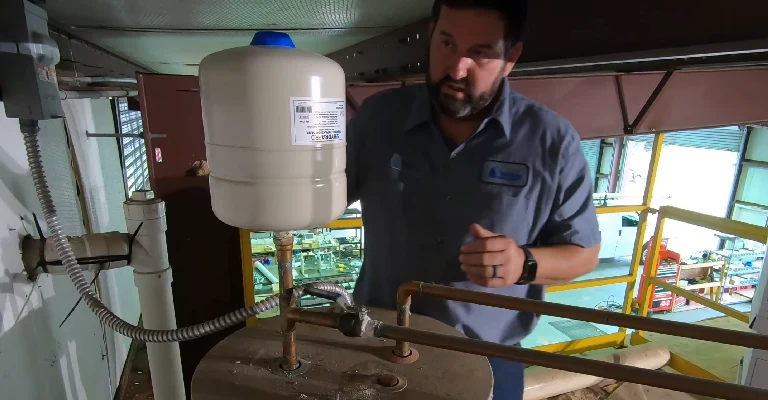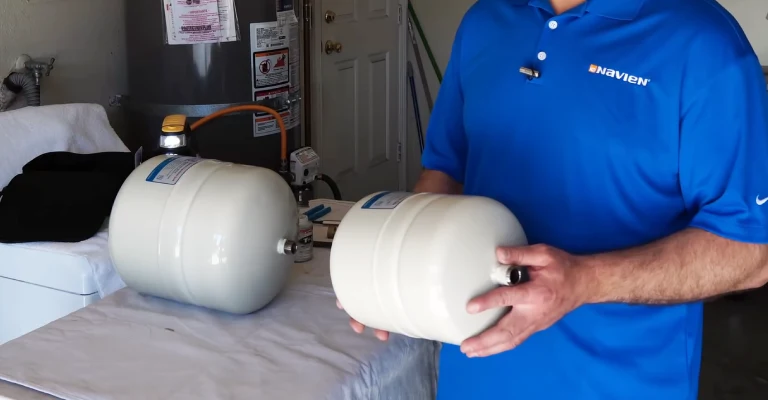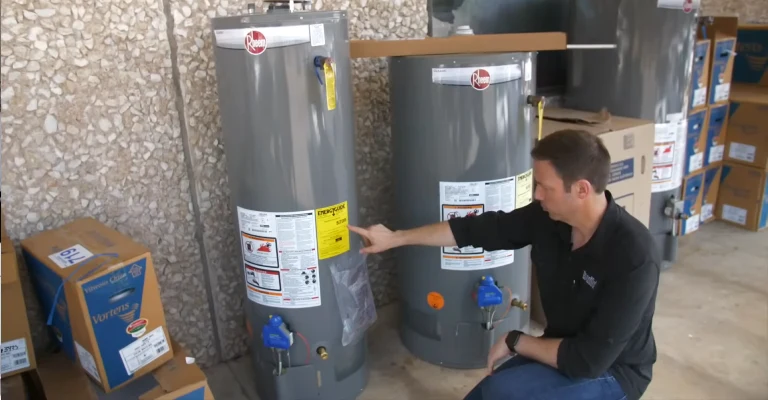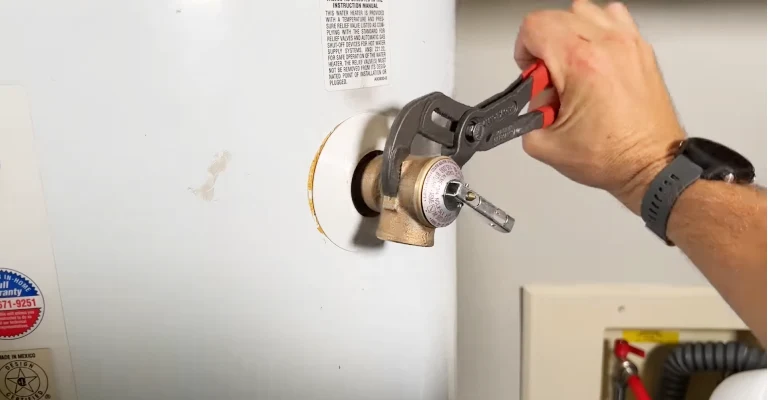Expansion tanks are an essential component in closed water supply systems, as they help to prevent damage to the system caused by changes in pressure.
The purpose of an expansion tank is to absorb the expansion of water as it is heated, preventing the pressure from building up in the system. They can also be used to maintain constant pressure in the system.
An expansion tank is not always required by code, but it may be required in certain situations.
The International Plumbing Code (IPC) and the International Residential Code (IRC) require an expansion tank to be installed in a closed water supply system when the supply pressure exceeds 80 psi.
Some local codes may also have specific requirements for expansion tanks. It’s always good to check with the local building department or consult with a licensed plumber to determine if an expansion tank is required for your particular situation.
What Does An Expansion Tank Do?

To explain how your tank-style water heater works, you must first understand how it works: Water expands as it is heated. You can experience this phenomenon because of thermal expansion. It can put stress on your water heater and plumbing.
Here’s how it works: When you heat water, it expands to about 52 gallons from 50 gallons. The extra volume will push against the walls of your water heater and plumbing if there is nowhere else for it to go.
Does The Code Require An Expansion Tank?
A water heater, plumbing system, and location determine if an expansion tank is required.
Location
An expansion tank will likely be required by code if you live in an area with strict plumbing codes. This requirement may apply to you whether you have an open or closed plumbing system.
Type of Plumbing System

National codes don’t specifically mention expansion tanks, but there is one stating that you need one if you have a closed plumbing system.
Once water enters the water main, a closed plumbing system prevents backflow out of the home’s plumbing system. Closed plumbing systems require expansion tanks for this reason.
- It is common for water to expand by up to 4% when heated.
- As a result, if your water heater holds 40 gallons, you’ll have an extra half gallon of water.
- A closed plumbing system will simply backflow into the city sewer system through the water main.
- Water can’t afford backflow in a closed plumbing system, so the extra water has to go somewhere.
- It is important to install thermal expansion tanks so that excess water can flow upward into the tank and wait until it has returned to its normal size before being redistributed.
- If you do not have an expansion tank, the water would expand and could burst your pipes or water heater.
Type of Water Heater

Lastly, tanked water heaters are only susceptible to expanding water. In this category are traditional tank-type water heaters, heat pump water heaters, and other water heaters that store heated water in a holding tank.
You don’t need a holding tank to store heated water when you have a tankless water heater that heats water on demand.
You do not need an expansion tank regardless of whether you have a closed plumbing system, or your local code requires one.
Does Code In Florida require Water Heater Expansion Tanks?
By IRC P2903.4, both original and replacement water heaters require a thermal expansion tank. Incompressible liquids such as water expand when heated, so this is necessary.
There is nowhere to expand water in your pipes without a thermal expansion tank. The result is that the water pressure increases, sometimes to a level that exceeds the plumbing rating.
Eventually, you will end up with leaks in your pipes, premature water heater failures, and problems with flush valves in your toilet and dishwasher.
In homes without a closed water supply system, one with a device that prevents your water from flowing backward into the public water supply piping and potentially contaminating it-expansion tanks are not required.
Florida, along with most jurisdictions, requires homes served by a public water utility have a backflow prevention device installed. Therefore, you can expect your next water heater to use a thermal pressure tank.
Doesn’t A Temperature & Pressure Relief Valve (T&P Valve) Do The Same Thing?

There is no simple answer to this question. Although the T&P Valve and Thermal Expansion Tank are both related to water heaters, their functions are quite different.
When temperature or pressure exceeds safety limits, the T&P prevents the tank from exploding.
Water heaters that are part of a closed system do not require a thermal expansion tank. An incoming water supply with a check valve prevents heated water from flowing back into the main by preventing expansion.
When a system is closed, and there is no expansion tank, the water heater heats the water, and when that water expands, the check valve block that expansion, which causes the pressure in the water heater to rise until it trips the T&P.
It is not enough to rely on the T&P alone to do the job. They sometimes fail to close after the pressure is relieved, even if you are willing to lose the water. In addition, sometimes the door won’t open when the T&P has failed.
Thermal expansion is not allowed by the Uniform Plumbing Code (UPC) or International Plumbing Code (IPC).
During this time, the T&P is likely to lime up and freeze closed, leaving it inoperative when needed to prevent explosions.
The pressure inside a malfunctioning water heater will continue to increase until it explodes if it continues to heat.
It is recommended that the T&P open at a predetermined pressure and/or temperature (usually 150 psi and 210F) to prevent an explosion.
T&Ps let overheated and/or under pressure water safely escape from tanks until the temperature and/or pressure falls below their preset levels, then they close the valve.
Do I Need a Thermal Expansion Tank on My Water Heater In Texas?
In reality, there isn’t just a yes or no answer, but there are some additional questions that need to be answered, which we will discuss later.
However, modifications, major repairs, and replacements must be done per the current codes. Until one of these “inciting” events occurs, a home is considered legal if it complies with building codes in force at the time of construction.
In the case of renovations or alterations, the work must meet the Building Code at completion time. Replacing or repairing a water heater must comply with the current Texas plumbing code.
What Happens if You Don’t Install an Expansion Tank?
When it comes to closed plumbing systems, you’ll probably regret it in the long run if you don’t install an expansion tank.
The power of water is particularly evident when it is contained within pipes and fixtures that are not designed to handle it above specified pressures.
When water is sufficiently heated, it expands and increases by approximately 4%. A water heater generates an excess amount of water vapor, which will further increase pressure.
As a result of the extra vapor and pressure created by the water, it evaporates when exposed to the elements. Alternatively, the water and pressure can flow into the city’s pipes if you have an open plumbing system.
A closed plumbing system cannot accommodate extra pressure because it is enclosed in pipes or tanks. It is, therefore, possible in this situation to experience several problems if you do not have an expansion tank.
- Water heaters are susceptible to bursting due to extra pressure, swelling, and expansion.
- You may experience a burst pipe due to extra pressure in your plumbing.
- A leak or burst will occur in the valves and pipes attached to the top of your water heater.
You will have to contend with extra pressure created by hot water once it gets into your plumbing system, and it will exert pressure until something breaks.
When Did Expansion Tanks Become Code?
Invented in 1954, expansion tanks are still in use today. Even though they have been around for over half a century, they weren’t required by code until 2006.
It became evident that an expansion tank code was necessary as damaged plumbing systems on closed plumbing systems were prevalent.
Expansion Tank Installation Code
The specific requirements for expansion tanks are listed in IRC P2903.4. The International Residential Code is the official book of plumbing codes for the United States.
The 2018 edition of the International Residential Code, the official United States plumbing code book, has a chapter 29: Water Supply and Distribution.
Any new or replaced water heater installed in a closed plumbing system must have an expansion tank.
Can You Run A Boiler Without An Expansion Tank?
It is possible to run a boiler without an expansion tank as long as your plumbing system is open or there is a pressure relief valve.
In contrast, if you have a sealed plumbing system and a tanked water heater, you need an expansion tank.
Do I Need an Expansion Tank if I Have a Pressure Tank?
There is no difference between a pressure tank and a thermal expansion tank. Installing a pressure tank will improve the lifespan and performance of your well pump.
However, expansion tanks are designed to hold hot water from water heaters. It’s important to understand that even though these two plumbing components look similar, they are not interchangeable.
In the case of a closed plumbing system, you will need an expansion tank regardless of whether you have a pressure tank.
Final Words
In life and in plumbing, thermal expansion tank requirements are not always black and white. In all closed plumbing systems, an expansion tank is required by the International Residential Plumbing Code.
Expansion tanks may not be necessary for those with tankless water heaters or other methods of eliminating extra pressure.
Even though there are other methods of reducing water pressure, thermal expansion tanks are the most tried and true method.
If you have a tanked water heater and a closed plumbing system, you must install an expansion tank to comply with plumbing code regulations.






